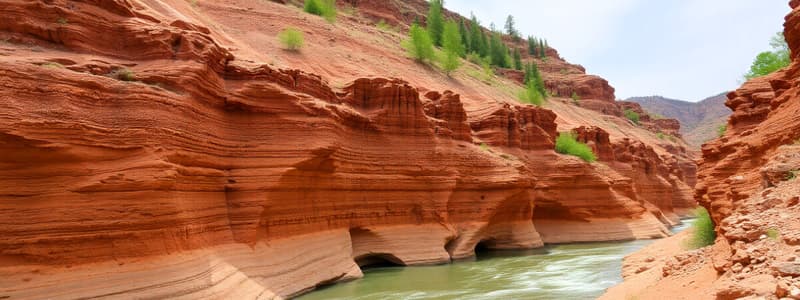Podcast
Questions and Answers
What is the source of a river?
What is the source of a river?
- The area where erosion primarily takes place
- The location where the river is widest
- The mouth where it empties into a lake or ocean
- The starting point where water is supplied by rain, other bodies of water, or melting snow and glaciers (correct)
How does erosion affect rivers?
How does erosion affect rivers?
- Erosion causes rivers to evaporate
- Erosion increases the flow speed of the river water
- Erosion fills rivers with sediment from the ocean
- Erosion moves weathered pieces of earth to other places (correct)
Which statement accurately describes the relationship between rivers and streams?
Which statement accurately describes the relationship between rivers and streams?
- Streams are small rivers that may flow into larger rivers (correct)
- Streams originate from the ocean and feed into rivers
- Streams are simply another term for fast-moving rivers
- Streams are larger and flow directly into oceans
Why do rivers often form rapids or waterfalls?
Why do rivers often form rapids or waterfalls?
What role does deposition play in river formation?
What role does deposition play in river formation?
What primary factor contributes to the formation of a V-shaped valley?
What primary factor contributes to the formation of a V-shaped valley?
Which type of stream is characterized by having multiple overlapping channels?
Which type of stream is characterized by having multiple overlapping channels?
Where does sediment deposition primarily occur in a river with meanders?
Where does sediment deposition primarily occur in a river with meanders?
Which geographical feature is typically formed when a river flows into a larger body of water?
Which geographical feature is typically formed when a river flows into a larger body of water?
What is a major risk associated with living on a floodplain?
What is a major risk associated with living on a floodplain?
Flashcards
What is a river's source?
What is a river's source?
The beginning of a river or stream, where water originates from sources like rain, other bodies of water, or melting snow and glaciers.
How do rivers form rapids and waterfalls?
How do rivers form rapids and waterfalls?
The rapid movement of water as it flows over steep slopes, creating features like rapids or waterfalls.
What is erosion?
What is erosion?
The process where moving water wears away and carries pieces of earth, shaping the landscape over time.
What is sediment?
What is sediment?
Signup and view all the flashcards
What is deposition?
What is deposition?
Signup and view all the flashcards
What is a river channel?
What is a river channel?
Signup and view all the flashcards
What are meanders?
What are meanders?
Signup and view all the flashcards
What are braided streams?
What are braided streams?
Signup and view all the flashcards
What are river deltas?
What are river deltas?
Signup and view all the flashcards
What are floodplains?
What are floodplains?
Signup and view all the flashcards
Study Notes
Rivers and Streams
- Rivers are large flowing bodies of water that flow into oceans or lakes
- Streams are small rivers
- Rivers and streams are found on most areas of the Earth
- Some flow year-round, others seasonally or only during heavy rainfall
Formation of Rivers and Streams
- Source: Beginning of a river or stream, supplied by rain, other water bodies, or melting snow/glaciers
- Rivers form high in mountains as slow-moving streams
- Water flows faster down steep slopes, creating rapids and waterfalls (water falling from a high place to a low place)
- Erosion: Water wearing away earth material and moving it elsewhere
- Rivers erode and create landforms
- Sediment: Earth pieces broken by erosion, carried downhill
- Deposition: Sediment is placed in another location, forming new landforms
- Fast-moving water deposits larger stones/pebbles; slow-moving water deposits smaller particles
- Mouth: End of a river where it flows into another large body of water (ocean or lake).
Rivers and Landform Creation
- Rivers alter the Earth's surface through erosion and deposition
- Features depend on slope, speed, and volume of river water
- Channels: Paths followed by rivers
- Meanders: S-shaped curves in rivers; fastest water erodes outside, slowest deposits sediment inside
- Braided streams: Multiple overlapping channels that continually change
- River valleys: Created by fast-moving water cutting across land (v-shaped in mountainous regions)
- River deltas: Triangular landforms made of deposited sediment when rivers meet larger bodies of water
- Alluvial fans: Fan-shaped sediment areas formed when water from steep slopes flows onto flat land
- Beaches: Shoreline landforms made of sand or gravel, material dependent on rocks eroded from mountains
River Flooding
- Rivers: important food, habitat, transportation, power, and recreation sources for humans
- Floodplains: Flat land near rivers, fertile for crops but not always suitable for buildings
- River flooding: Overflowing river water causes damage and hazards (drowning, home/structure damage, destruction of wildlife habitats).
- Flooding causes: Heavy rainfall or fast-melting snow (seasonal)
- Flooding prediction: Difficult, as many rivers don't flood in regular patterns
Studying That Suits You
Use AI to generate personalized quizzes and flashcards to suit your learning preferences.




